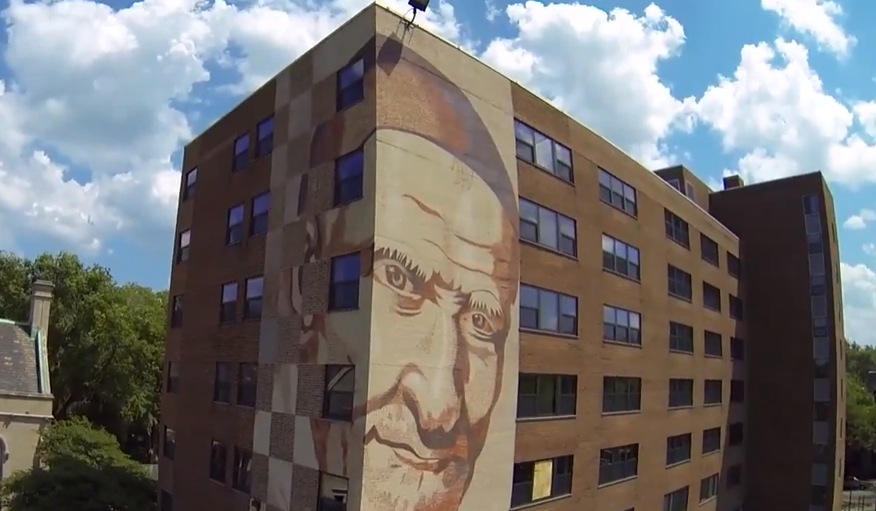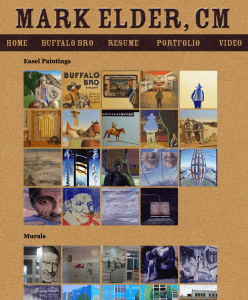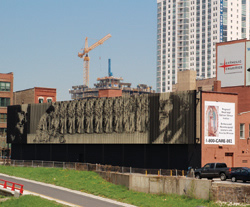 Brother Mark Elder CM makes an art of spirituality He is the creator of some of the most striking murals in the United States and elsewhere, uses art in his quest to help the poor and disenfranchised.
Brother Mark Elder CM makes an art of spirituality He is the creator of some of the most striking murals in the United States and elsewhere, uses art in his quest to help the poor and disenfranchised.
Cliff Terry writes on the VocationNewtwork site…
When Mark Elder, a Vincentian brother, is asked why he became a brother instead of a priest, he likes to reply, “I didn’t want to work on Sundays.”
“It’s a joke, of course,” he says with a grin. “But there’s a small bit of truth to that.”
As a child, Mark Elder had familiar boyhood dreams of what he wanted to be. A professional baseball player, perhaps. Certainly, a Marine fighter pilot like his dad. But life takes its own turns, and Mark Elder is not only a member of the Congregation of the Mission (the Vincentians) but a highly respected instructor of art, university public art coordinator at Chicago’s DePaul University, and creator of some of the most striking murals in the United States and elsewhere.
In fact, Elder’s students at DePaul often ask him to explain the difference between being a brother and a priest. “I try to pin it down the best I can,” he says. “I tell them that, traditionally, brothers were mostly monastic, and they would ordain a few of them as priests to serve their needs [for Mass and the sacraments]. But the Vincentians are different. They’re a religious group that’s mainly a group of priests—and then there are a few knuckleheads like me. But basically we all strive to do various works for the evangelization of the poor and disenfranchised as best we can.
“I liked the idea of religious life, but there were some things about the priesthood that wouldn’t be too conducive for me. So I’d rather stay as a brother, do the work, and let it go at that. I can’t really put my finger on any one thing. I knew I’d have a hard time studying theology. I didn’t know if I could really hold on to enough discipline to learn it properly.”
Among his artworks is a most strikingly impressive one, right on the DePaul campus in the city’s trendy Lincoln Park neighborhood. It wraps around two sides of a dormitory. The 70-by-36-foot mural, “We Are DePaul 2,” is a gigantic portrait of Saint Vincent DePaul himself. Upon closer look, it is made up of what Elder calls “little, bitty faces”—students, faculty, staff members from the university’s community.
| BROTHER MARK ELDER’S MURAL, “The Mandatum,” is seen by tens of thousands daily from Chicago’s Kennedy Expressway. |
“All the faces are based on drawings I made, so there’s a series of 16 faces repeated throughout,” he explains. “I did it with a German masonry paint, mineral silicate, which is very durable and should last 70 years. The university commissioned the mural. I had come up with the idea as part of our centennial celebration. People will see the faces and say, ‘Yeah, I know that guy,’ or, ‘How come I’m not on there?”
Another huge Elder work, “The Mandatum” (2003), is a “shadow mural”—152 feet-by-22 feet—on a wall of the Catholic Charities building on Randolph Street in downtown Chicago just off the Kennedy Expressway. The full effect of the piece depends on from what angle one is looking.
Elder learned about the technique during a stay in Rome. “It was an epiphany for me. I felt the providence of God came down upon me and said, ‘Look, you have to learn how to do this because this is how you’re going to handle the Catholic Charities building.’ I call it a shadow image technique, and, as far as I know, this is the first time it’s been used in the United States. It’s made of strips of quarter-inch aluminum mounted on steel.”
The mural consists of two representations: Vincent DePaul and Frédéric Ozanam, founder of the Society of St. Vincent DePaul. “Here were two geniuses at creating programs for the poor,” Elder notes. “When you look at these portraits straight on, you get a pure shadow effect, and it’s very ghostlike. When you move to one side, it becomes more pronounced.”
In between is a scene from the Last Supper, where Christ is washing the feet of one of the disciples. “I like to have fun with something like this,” Elder says. “You see this figure right over here? Well, there’s my malcontent. Judas? Could be? Could be anybody, really. It could be any of us, because there’s always somebody in the crowd who’s not too happy for whatever reason.
“It was not cheap to put up. It took quite an effort, and we had to get sizable donations from foundations and individuals. The aluminum alone was $100,000. The great thing was I never really had to twist anybody’s arm. All I had to do was show these two guys here, and people would become fascinated. My pièce de résistance? Yeah, right now it is.”
“Mark is a man of great passion and faith who expresses it in visually stunning ways,” says Father Ron Hoye, director of vocations for the Congregation of the Mission. “He shows me that being unique and, well, different than the norm is a blessing. His walking around Chicago in a cowboy hat and duster jacket reminds me that Jesus calls all kinds! His spirituality is inextricably tied to his gift as an artist. By just doing what he loves to do—paint—he is witnessing to the love and presence of Jesus in today’s world.”
“Brother Mark is down-to-earth, laid-back, and certainly something of a character,” adds Father Christopher Robinson, an assistant professor of religious studies at DePaul. “And he clearly is Vincentian in that the theme of much of his art relates to charity and a concern for the poor. Students enjoy his classes, particularly one I met who painted a mural on the side of a school in a rough part of town.”
Elder, 51, draws a close connection between his vocation and his work as an artist. “When I see what my work is doing, especially when I work with a group on a mural, the art somehow promotes all the values that I believe in. And by making the art more or less democratic, the people take ownership. For example, there’s “Spirit of Sacred Heart,” an acrylic-on-concrete mural at Sacred Heart Catholic School in Patterson, California. We had not only all the kids from the school working on it, but some of the parents. You know, it’s just as much their mural as it is mine. And there’s a source of pride in that, a means of empowerment. And by doing that, in a way, you can evangelize through that. Same thing with a mural at the Pilsen Neighbors Community Council Building in Chicago’s Pilsen [largely Mexican American] neighborhood.”
For more on his background visit VocationNewtwork
Elder’s decision to become a brother didn’t occur because of some sudden epiphany but just evolved. He had heard about the seminary through a cousin, who had gone there. (“When I started, I had no ambition to become a priest or brother.”) But after graduation, he decided to explore things a little further by entering a Vincentian novitiate in Santa Barbara, California. “It was a wonderful seminary, up in the hills, very scenic,” he remembers. “And, you had no formal studies. So basically you were there, really, to bring your spiritual life together the best you could—at the age of 18 or 19. [Laughter.] We did the best we could, and I just ended up being very attracted to it. I couldn’t think of anything else I’d rather do. So that year was really important.”
Other Elder works (click graphic to visit his portfolio)
 Mark Elder’s artworks also include “The Vincentian Family: The Gleaners,” a mural in the lobby of the Vincentian headquarters in Rome, which depicts the five Vincentian virtues: simplicity, humility, meekness, mortification, and zeal. (“Zeal is the only one in full color,” he notes with a smile.)
Mark Elder’s artworks also include “The Vincentian Family: The Gleaners,” a mural in the lobby of the Vincentian headquarters in Rome, which depicts the five Vincentian virtues: simplicity, humility, meekness, mortification, and zeal. (“Zeal is the only one in full color,” he notes with a smile.)
Among others are “Charity Along the Trail of Tears,” a painting in the Museum of the Trail of Tears State Park outside of Jackson, Missouri, based on the tragic plight of ill-clad and sick Cherokee Indians who were expelled from their native lands in eastern Tennessee and, crossing the Mississippi River during winter, lost thousands of their members; and “Alien Sightings at the Great Wall of America,” which Elder calls “one of my political paintings,” depicting the immigration situation at the California-Mexico border.
“And I hope that this summer I’ll be working on a mural, ‘The Roots of Argyle,’ on the site of a grocery store in Uptown, which is becoming more and more an Asian community,” he says. “The neighborhood asked me to do it, with each façade representing a generation in the growth of the Argyle neighborhood. Incidentally, I discovered it was the site of one of the first motion picture studios, Essanay, home of Charlie Chaplin, Gloria Swanson, and the first movie cowboy, ‘Bronco Billy’ Anderson. Anyway, when I was talking to the alderman up there, she at first didn’t think a mural would be the way to go, and I said, ‘What do you have against murals?’ She said, ‘They’re always about these social justice things. We’ve been social-justiced to death.’ I said, ‘We don’t have to do overtly social justice, but underneath, by treating everybody the same, then we have this platform. She finally said, ‘OK.’ ”
Elder became a Vincentian simply because he attended a Vincentian seminary. “Their mission is to serve the poor. Vincent DePaul was the great inventor of the concept of organized charity.” He went on to the Vincentians’ seminary in Perryville, Missouri. After two years, it was decided that he should go to DePaul to get a degree in physical education so he could teach. After graduating in 1979, he taught at every level from kindergarten to 12th grade in Cape Girardeau, St. Louis, and East St. Louis.
Next, he was asked to run an art-related program at the Vincentians’ St. Thomas Seminary in Denver, where he earned a master of fine arts degree from the University of Denver. From then on, his teaching was devoted to art instead of physical education. For 10 years, he has been teaching at DePaul, where his classes include a basic class for non-art majors.
It was after high school that he realized he liked to teach young people. His passion for art developed later. “All along, I became more and more infatuated by teaching myself how to paint,” he recalls. As a young kid, I was interested in art a little bit, but not as much as most artists would be. I would say I was a late bloomer. When I got seriously interested in art, I was about 35.”
At DePaul, Elder tries to involve his students directly in various service works. “For instance, I teach a class called Art and Social Interaction. We go out to the particular community where we’ve been invited, the class deals with the process of mural making, either indoors or outdoors, and we take in a lot of input from the community and paint a mural based on that input. My students have done these murals around Chicago.”
As for advice for young people considering a vocation to religious life: “I would say just be open, and try to relax and let the Spirit communicate with you as to what God is calling you to do. If it ends up that you should stay with it, at least you have a better conviction knowing that. Vincentians always question why someone comes to us, but it’s better that we question why they stay. That’s the bigger question.”
Elder himself seems to have plenty of reasons both for becoming and remaining a brother. “I love to see that I left somebody interested in either wanting to do what I do or happy that I was there with them. You know, the work is fantastic. . . . I honestly don’t know what I’d be doing if I weren’t doing this. I mean it’s a great life.”








“I knew I’d have a hard time studying theology,” says Brother Mark. Please allow me to suggest that he has done better than just study; he has done theology for the public, especially the disenfranchised.
Great Work, Brother Mark!!!!